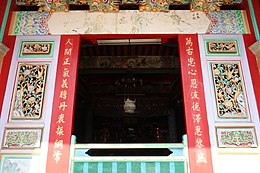

| Duilian | |||||||||||||||||||||||||
|---|---|---|---|---|---|---|---|---|---|---|---|---|---|---|---|---|---|---|---|---|---|---|---|---|---|

| |||||||||||||||||||||||||
| Chinese name | |||||||||||||||||||||||||
| Traditional Chinese | 對聯 | ||||||||||||||||||||||||
| Simplified Chinese | 对联 | ||||||||||||||||||||||||
| |||||||||||||||||||||||||
| Vietnamese name | |||||||||||||||||||||||||
| Vietnamese alphabet | Đối liên Câu đối | ||||||||||||||||||||||||
| Chữ Hán | 對聯 | ||||||||||||||||||||||||
| Chữ Nôm | 句對 | ||||||||||||||||||||||||
| Japanese name | |||||||||||||||||||||||||
| Kanji | 対聯 | ||||||||||||||||||||||||
| Hiragana | ついれん | ||||||||||||||||||||||||
| |||||||||||||||||||||||||
InChinese poetry, a duilian (simplified Chinese: 对联; traditional Chinese: 對聯; pinyin: duìliánⓘ) is a pair of lines of poetry which adhere to certain rules (see below). Outside of poems, they are usually seen on the sides of doors leading to people's homes or as hanging scrolls in an interior. Although often called Chinese couplet or antithetical couplet, they can better be described as a written form of counterpoint. The two lines have a one-to-one correspondence in their metrical length, and each pair of characters must have certain corresponding properties. A duilian is ideally profound yet concise, using one character per word in the style of Classical Chinese. A special, widely-seen type of duilian is the chunlian (simplified Chinese: 春联; traditional Chinese: 春聯; pinyin: chūnlián), used as a New Year's decoration that expresses happiness and hopeful thoughts for the coming year.
A duilian must adhere to the following rules:
Example of a duilian:
| Bottom | Top | ||
|---|---|---|---|
| knowledge | 學 | 書 | book |
| sea | 海 | 山 | mountain |
| have not | 無 | 有 | have |
| border | 涯 | 路 | way |
| painstaking | 苦 | 勤 | diligence |
| makes | 作 | 爲 | is |
| boat | 舟 | 徑 | path |
Originating during the Five Dynasties, and flourishing during the Ming and Qing dynasties in particular, duilians have a history of more than a thousand years and remain an enduring aspect of Chinese culture.
Often, duilians are written on red paper and stuck on walls. Sometimes, they are carved onto plaques of wood for a more permanent display.
Dueling duilians are a popular pastime with Chinese speakers,[1] a game of verbal and intellectual dexterity, wit, and speed which shares some parallels with the dozens.
|
| |
|---|---|
| Major eras |
|
| Poetry by dynasty |
|
| Poetry works and collections |
|
| Major forms |
|
| Individual poems list |
|
| Modern compilations |
|
| Regional styles |
|